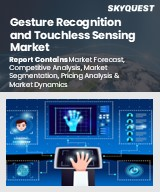
세계의 제스처 인식·터치리스 센싱 시장 규모는 2023년에 187억 달러에 달하며, 예측 기간(2025-2032년)의 CAGR은 19.1%로, 2024년 222억 7,000만 달러에서 2032년에는 901억 7,000만 달러로 성장할 전망입니다.
세계 제스처 인식 및 터치리스 센싱 시장은 급속한 기술 발전, 정부 정책 강화, 소비자 선호도 변화 등에 힘입어 강력한 성장세를 보이고 있습니다. 특히 공중보건과 스마트 시티 구상에서는 터치리스 기술을 중시하는 경향이 강화되고 있으며, 정부는 디지털 인프라 강화를 촉구하고 있습니다. 기술, 특히 머신러닝과 인공지능의 통합에서의 큰 혁신은 제스처, 표정, 공간적 움직임에 반응하는 실시간 적응형 인터페이스를 가능하게 하여 인간과 컴퓨터의 상호 작용을 완전히 변화시켰습니다. 또한 에너지 효율이 높은 센서와 태양광발전 장치의 등장은 환경 지속가능성과 친환경 기술을 향한 세계적인 추세와 맞물려 제스처 인식 및 터치리스 센싱 산업을 미래의 혁신적 솔루션의 최전선에 위치시키고 있습니다.
Global Gesture Recognition and Touchless Sensing Market size was valued at USD 18.7 billion in 2023 and is poised to grow from USD 22.27 billion in 2024 to USD 90.17 billion by 2032, growing at a CAGR of 19.1% during the forecast period (2025-2032).
The global market for gesture recognition and touchless sensing is witnessing robust growth fueled by rapid technological advancements, enhanced government initiatives, and shifting consumer preferences. Increasing emphasis on touchless technologies, particularly within public health and smart city initiatives, is prompting governments to strengthen digital infrastructure. Significant breakthroughs in technology, particularly the integration of machine learning and artificial intelligence, have transformed human-computer interaction, allowing for real-time adaptive interfaces that respond to gestures, facial expressions, and spatial movements. Furthermore, the rise of energy-efficient sensors and solar-powered devices aligns with the growing global trend towards environmental sustainability and green technology, positioning the gesture recognition and touchless sensing industry at the forefront of innovative solutions for the future.
Top-down and bottom-up approaches were used to estimate and validate the size of the Global Gesture Recognition and Touchless Sensing market and to estimate the size of various other dependent submarkets. The research methodology used to estimate the market size includes the following details: The key players in the market were identified through secondary research, and their market shares in the respective regions were determined through primary and secondary research. This entire procedure includes the study of the annual and financial reports of the top market players and extensive interviews for key insights from industry leaders such as CEOs, VPs, directors, and marketing executives. All percentage shares split, and breakdowns were determined using secondary sources and verified through Primary sources. All possible parameters that affect the markets covered in this research study have been accounted for, viewed in extensive detail, verified through primary research, and analyzed to get the final quantitative and qualitative data.
Global Gesture Recognition and Touchless Sensing Market Segments Analysis
Global Gesture Recognition and Touchless Sensing Market is segmented by Technology, Organization Size, Application, End User and region. Based on Technology, the market is segmented into Touchless Biometric Systems, Gesture Recognition Systems and Voice Recognition Interfaces. Based on Organization Size, the market is segmented into Large & Medium Enterprises and Small Enterprises. Based on Application, the market is segmented into Hand Gesture Recognition, Facial Recognition and Motion Detection. Based on End User, the market is segmented into Automotive, Consumer Electronics, Healthcare, BFSI, Retail, Gaming & Entertainment and Government & Defense. Based on region, the market is segmented into North America, Europe, Asia Pacific, Latin America and Middle East & Africa.
Driver of the Global Gesture Recognition and Touchless Sensing Market
The demand for touchless interaction has surged, fueled by a growing emphasis on hygiene and user-friendly solutions across various sectors, including healthcare, retail, and public infrastructure. This shift towards gesture and voice-based technologies reflects a broader societal preference for hygienic alternatives, transforming touchless technology from a luxury into a necessity. As organizations seek to minimize physical contact in environments ranging from shopping malls to healthcare facilities, the market for gesture recognition and touchless sensing technologies has experienced significant growth. This increasing reliance on non-contact solutions underscores the changing landscape of consumer expectations and the evolving dynamics of interaction.
Restraints in the Global Gesture Recognition and Touchless Sensing Market
The Global Gesture Recognition and Touchless Sensing market faces several constraints that hinder its growth potential. One major challenge is the high cost associated with advanced sensors, 3D cameras, and AI technology, which can deter small and medium-sized enterprises, especially in regions with elevated expenses. Furthermore, in emerging economies, limited infrastructure and constrained research and development budgets contribute to slower adoption rates. As a result, despite a strong demand for gesture recognition and touchless sensing solutions, market penetration remains low in rural and underdeveloped areas, ultimately impeding global expansion and limiting the overall market's reach.
Market Trends of the Global Gesture Recognition and Touchless Sensing Market
The Global Gesture Recognition and Touchless Sensing market is witnessing a significant shift as consumer technology increasingly embraces intuitive interfaces that prioritize hands-free operation. Major brands are integrating sophisticated gesture controls and touchless functionalities into everyday devices, such as smartphones, smart TVs, and wearables. This trend is driven by rising consumer demand for seamless, interactive experiences within interconnected, AI-enhanced environments that enhance ease of use. As these technologies evolve, they are reshaping how users engage with their devices and transforming the landscape of smart home ecosystems, ultimately leading to a more immersive and efficient digital lifestyle.